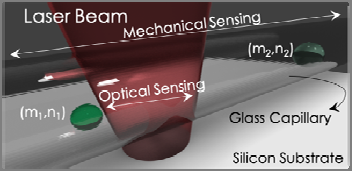CSIC has developed a sample analyzing system that can identify particles and/or biological cells in
aqueous suspension or in physiological medium. The system allows simultaneously measuring the mass
and light scattering of the particles in suspension in real time. This technology has been used to
distinguish different cell lines, making it useful for diagnosing diseases.
Industrial partners manufacturers of lab equipment are sought to collaborate through a patent license
agreement.
An offer for Patent Licensing
Reliability with just one measurement
Mechano-optical detection system. Two particles with different mass and refraction index flow inside, across a resonant capillary. By measuring mechanical resonance, the mass of the particles can be obtained and by analysing reflectivity is possible to obtain refraction index.
By simultaneous measuring both parameters it is possible to distinguish these particles.
Currently, one widely used technique to characterize particles dispersed in liquid medium is based on mechanical hollow resonators. However, this type of systems, despite their high sensitivity, are not able to distinguish among different particles of similar buoyant masses (difference between the mass of the displaced liquid and the mass of the immersed object). So far, the only solution to this problem is performing multiple measurements changing the carrier liquid, which increases costs and complexity of the process. Nevertheless, this method is not suitable for biological analyses, where carrier liquid cannot be arbitrarily changed.
Mechano-optical system developed by CSIC allows an unequivocal differentiation of particles by the simultaneous determination of its buoyant mass and its reflectivity, using a single laser. Using an optical method allows a precise determination of buoyant mass, providing an additional parameter for differentiation. It allows to distinguish between particles that despite having similar buoyant mass, are actually different.
Main innovations and advantages
· Suitable for the identification of particles and/or biological cells inaqueous suspension or physiological media.
· It allows a reliable analysis without the need to perform multiplemeasurements, having a direct impact on costs.
· It allows to distinguish particles that despite having different density andvolume they have similar buoyant mass.
· It´s suitable for the identification and classification of tumor and non-tumor cells. In particular, it has been tested to identify epithelial cell ofbreast tissue.
· These devices are transparent, being consequently compatible with theuse of additional lasers and fluorescent markers. This technology willenable the simultaneous study of tens of cell proteins (fluorescentmarkers), together with biophysical analysis of these individual cells(mass and reflectivity).






